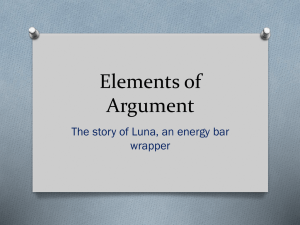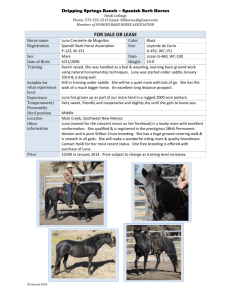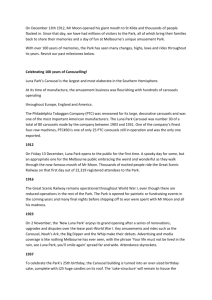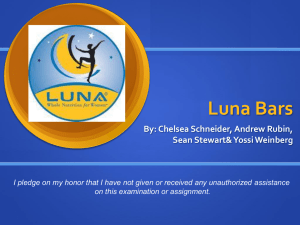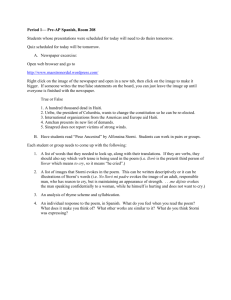The Jonathan Luna Case Study: An Unsolved - e
advertisement
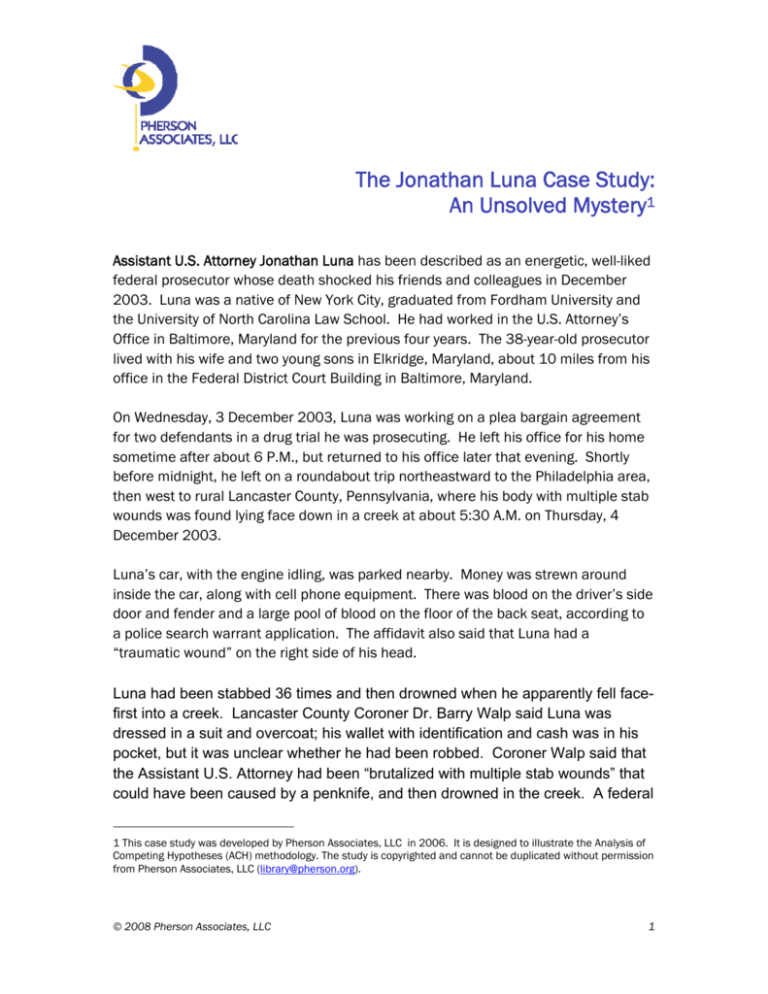
The Jonathan Luna Case Study: An Unsolved Mystery1 Assistant U.S. Attorney Jonathan Luna has been described as an energetic, well-liked federal prosecutor whose death shocked his friends and colleagues in December 2003. Luna was a native of New York City, graduated from Fordham University and the University of North Carolina Law School. He had worked in the U.S. Attorney’s Office in Baltimore, Maryland for the previous four years. The 38-year-old prosecutor lived with his wife and two young sons in Elkridge, Maryland, about 10 miles from his office in the Federal District Court Building in Baltimore, Maryland. On Wednesday, 3 December 2003, Luna was working on a plea bargain agreement for two defendants in a drug trial he was prosecuting. He left his office for his home sometime after about 6 P.M., but returned to his office later that evening. Shortly before midnight, he left on a roundabout trip northeastward to the Philadelphia area, then west to rural Lancaster County, Pennsylvania, where his body with multiple stab wounds was found lying face down in a creek at about 5:30 A.M. on Thursday, 4 December 2003. Luna’s car, with the engine idling, was parked nearby. Money was strewn around inside the car, along with cell phone equipment. There was blood on the driver’s side door and fender and a large pool of blood on the floor of the back seat, according to a police search warrant application. The affidavit also said that Luna had a “traumatic wound” on the right side of his head. Luna had been stabbed 36 times and then drowned when he apparently fell facefirst into a creek. Lancaster County Coroner Dr. Barry Walp said Luna was dressed in a suit and overcoat; his wallet with identification and cash was in his pocket, but it was unclear whether he had been robbed. Coroner Walp said that the Assistant U.S. Attorney had been “brutalized with multiple stab wounds” that could have been caused by a penknife, and then drowned in the creek. A federal 1 This case study was developed by Pherson Associates, LLC in 2006. It is designed to illustrate the Analysis of Competing Hypotheses (ACH) methodology. The study is copyrighted and cannot be duplicated without permission from Pherson Associates, LLC (library@pherson.org). © 2008 Pherson Associates, LLC 1 law enforcement official at the time told reporters on condition of anonymity that “they were defensive wounds.” Walp, however, said that he did not observe any defensive wounds during the autopsy. Defensive wounds are typically found on the hands and arms when a victim tries to protect himself from the knife thrusts of an attacker. Walp said Luna’s wounds were all in the neck and upper chest. Luna’s family members and friends said they believed his death was connected to his job. During his career, he had prosecuted drug dealers, armed robbers, and child molesters. Initial Investigation Phase The discovery of Luna’s body came at the close of his prosecution of a violent drug trafficking organization. Jonathan Luna had been prosecuting Baltimorebased rap musician Deon Lionnel Smith and his one-time associate, Walter Oriley Poindexter, who were accused of heroin distribution and running a violent heroin ring from their Stash House Records Studio. Smith pleaded guilty to distribution of heroin and use of a handgun in a drug-trafficking crime. Poindexter pleaded guilty to three counts of distribution of heroin. Conspiracy charges against them were dropped. Smith and Poindexter were in jail at the time of Luna’s death. Smith’s attorney, Kenneth Ravenell, said it would make no sense for his client or Poindexter to be involved. According to Ravenell, the plea deal that Smith agreed to was the same deal that he offered to the prosecutors two weeks before the trial. Ravenell told a TV news anchor “Mr. Luna was instrumental in negotiating the deal and convincing his office that it was a proper deal. So both men had the deal they sought from the prosecution.” Investigators pored over Luna’s financial records and computer files, and combed through his phone logs and palm pilot entries. They also looked into other cases Luna has prosecuted in the past few years, which included drug gangs and violent criminals, but came up with no promising leads. Authorities found traces of blood from a second person in Luna’s car, but released no information on the results of a DNA analysis. An anonymous law enforcement source said that authorities also found a partial fingerprint in the car. Investigators also found a bloodstain on a toll booth ticket that the driver of Luna’s car turned in to a toll booth collector on leaving the Pennsylvania Turnpike © 2008 Pherson Associates, LLC 2 in Lancaster, Pennsylvania. Since Luna’s car, however, was equipped with EZPass, raising the question why a paper ticket was used. Investigators questioned all the gas station attendants, motel operators, and food vendors at the ReadingLancaster interchange for any sightings of Luna without success. Further Probing As the investigation proceeded, authorities began to turn up unusual trips to Philadelphia by Luna, personal debts, and private internet communications. Sources told reporters that investigators had found Luna’s name on adult web sites. The sources said that the messages sought women for sexual encounters. Some sources also said that the location where Luna’s body was found is a place where people have been said to seek other people for sexual encounters. Local officials have denied that the area is such a location. Luna’s father told authorities that Luna had traveled to the Philadelphia area several times in the month preceding his death. He even canceled a Thanksgiving weekend trip to New York City, telling his father “I have a case. I have to go to Pennsylvania.” Officials said he had no court business in Pennsylvania. However, lawyers connected to the drug conspiracy case that was underway in Baltimore have said that a key witness in that case was being detained in the Philadelphia area, and that Luna went there several times to interview him. Investigators have also been looking into the unsolved disappearance of about $36,000 introduced as evidence in a bank robbery that Luna prosecuted in 2002. Luna had filled out a loan application online about the time of the trial. According to a federal law enforcement source, Luna’s loan application was for about $30,000, but it was canceled not long after the evidence money was discovered to be missing. Authorities have also determined that Luna had credit card debts of about $25,000 at the time of his death. He had as many as 16 credit cards, some of which he held without his wife’s knowledge. In addition to possible financial problems, several legal sources said that Luna felt that he was on the outs with his supervisors in the U.S. Attorney’s office where he had worked for four years. U.S. Attorney Thomas M. DiBiagio, however, has rejected any suggestion that Luna was at risk of being fired. © 2008 Pherson Associates, LLC 3 Federal law enforcement officials in March 2004 told CNN that investigators were divided on the question of whether Luna was killed or whether the dozens of small knife wounds were self-inflicted. When the body was discovered, Lancaster County coroner Dr. Barry Walp said that Luna had suffered a number of shallow “prick” marks on his chest in addition to several deeper, more serious stab wounds. Although rare, there have been instances of suicides by stabbing, which have been marked by so-called “hesitation wounds” that barely penetrate the skin. Some two months after Luna’s killing, investigators found a penknife in the field near where his body was found. Authorities believe it was Luna’s own pocketknife and that it was the knife that caused his wounds. Officials have not said whether they found fingerprints or blood on the knife, nor why it was not discovered during an extensive search of the scene on the day Luna’s body was found. Authorities have sought assistance from the Armed Forces Institute of Pathology to examine medical and psychological evidence in the case in an effort to resolve the sensitive question of whether Luna could have killed himself. Autopsy findings by the medical examiner in Lancaster County, Pa, have not been made public, and forensic pathologist Dr Wayne K. Ross, who performed the autopsy, has refused to discuss the case with reporters. The FBI has offered a $100,000 reward for information that will help federal agents determine whether Luna’s death was a premeditated homicide, suicide, or random act of violence. Luna’s Last Hours In March 2004, the FBI released what it knew of Luna’s final hours from Wednesday evening, 3 December, when he left the Federal Courthouse in Baltimore, Maryland at 11:38 P.M., to the time he his body was found at 5:30 A.M., Thursday, 4 December (See appendix). Electronic toll data provided most of the evidence of the route taken by Luna’s car. The times of events earlier in the evening have been provided to the press by anonymous law enforcement officials. Luna took a roundabout route from his Baltimore office to the creek in Lancaster, Pennsylvania. He drove northeastward on I-95 from Baltimore to Delaware and then toward the Philadelphia area (see map). © 2008 Pherson Associates, LLC 4 Luna was at the Federal District Court Building in Baltimore at 5:00 PM to work on the agreement for the Poindexter plea bargain. He left by 6:00 PM apparently to go to his home in the Baltimore suburb of Elkridge, Maryland. Poindexter’s attorney, Arcangelo Tuminelli, said he received a phone call from Luna at 9:06 P.M. in which the prosecutor said he was still drawing up the paperwork for the plea and making sure it was all correct. Tuminelli said he did not know where Luna was at that time, but he said Luna told him he had to go home and would be back in his office in the federal courthouse later. Tuminelli said that he assumed he would receive a fax from Luna by about midnight, but the fax never came. According to an unconfirmed report from an unspecified source, Luna around 9:30 PM left a voice mail message on Attorney Ravenell’s phone saying he would fax the plea agreement later. Around 11:00 PM Luna received a cell phone call and told his wife he had to return to the office. The identity of the caller was not disclosed. Luna leaves home shortly afterwards. Luna’s car leaves the Federal Court parking garage at 11:38 P.M. His cell phone and eyeglasses were later found in his office. Luna’s car, equipped with EZ-Pass, passed through the Fort McHenry Tunnel toll gate, heading north, at 11:49 PM. Luna’s car passed through the Perryville, Maryland toll plaza, northbound, at 12:28 AM through the Delaware Line toll plaza, northbound. Luna’s first known stop was the JFK Plaza in Newark, Delaware at 12:57 AM. His debit card was used to make a $200 ATM withdrawal, but there is no videotape on the security cameras capturing that transaction. He apparently continued north into the Philadelphia area and on to the New Jersey Turnpike and the Pennsylvania Turnpike. Tolls are only taken westbound (NJ to PA), so there is no electronic record of the crossing from DE to NJ or PA to NJ. At 2:37 A.M. (approximate time), Luna’s car entered the New Jersey Turnpike at interchange 6A from New Jersey Route 130 and at 2:47 A.M. it entered the Pennsylvania Turnpike at exit 359, the Delaware River Bridge. The car then exited the Pennsylvania Turnpike and reentered, picking up a paper toll ticket rather than passing through the EZ-Pass lane. . At 3:20 AM, Luna pulled into a service plaza along the Pennsylvania Turnpike in King of Prussia, PA, in the western suburbs of the metropolitan Philadelphia area. Employees at a Sunoco Station said he bought gasoline, a snack, and a © 2008 Pherson Associates, LLC 5 soda, but authorities found no sign of him on the grainy video surveillance tapes. Investigators are trying to determine whether another man who can be seen on the tape could have been traveling with Luna at that point. Assistant Manager Sham Vaid said Luna put two tanks of gas on his credit card. According to the Baltimore Sun, another employee, Moustapha Balde, told The Philadelphia Inquirer that he had seen Luna about 3:00 A.M. when he purchased drinks. Balde told the Inquirer that Luna did not appear to be under any duress. “He was just very calm. He must have been with people, but I don’t think he knew they were going to kill him” Balde said. After interviewing the employees and reviewing surveillance videos and cash register receipts, investigators did not believe there was a second car traveling with Luna. A Roy Rogers Restaurant manager, Kathy Seidel, at a rest stop in Elverson, PA, 30 miles west, said she saw Luna there. She said that she remembers he looked like TV host Bryant Gumbel. She did not recall seeing anyone else with him. FBI agents would not say whether Seidel’s account is credible. It would have been difficult for Luna to have been in King of Prussia after 3 A.M., paid for his purchases, returned to the turnpike, and reached Elverson before 3:30 A.M. Twenty miles and two exits west of Elverson, Luna’s vehicle exited the Pennsylvania Turnpike at the Reading-Lancaster interchange. Exit 286, at 4:04 AM. A paper ticket, with blood spots on it, was turned in to the toll booth attendant. The exit drops drivers into a small, well-lit strip of all-night gas stations and motels. Investigators visited all of them and found no leads. The lights quickly disappear as the road winds into Brecknock Township and Amish country. At 5:30 AM, a Sensening and Weaver employee reported an unknown car on company property, its engine still idling. Luna’s body was found lying face down in the creek off Dry Tavern Road, in Lancaster County, Pennsylvania. According to the Lancaster County coroner, Dr. Barry Walp, Luna was alive when his car entered the parking lot and pulled up to the creek. He died of fresh-water drowning and his stab wounds. Officials would not comment on how the killer might have escaped. © 2008 Pherson Associates, LLC 6
